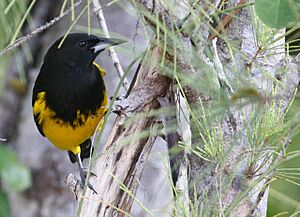Bahama oriole facts for kids
Quick facts for kids Bahama oriole |
|
|---|---|
 |
|
| Conservation status | |
| Scientific classification | |
 |
The Bahama oriole (Icterus northropi) is a special type of songbird. It belongs to the New World blackbird family, called Icteridae. This bird lives only in the Bahamas. Because there are so few of them, it is listed as an endangered species.
Contents
About the Bahama Oriole
How We Know This Bird
The Bahama oriole was first identified as its own unique species in 1890. This was done by a scientist named Joel Asaph Allen. Later, some scientists thought it was the same as other orioles. These included the Cuban oriole, Hispaniolan oriole, and Puerto Rican oriole.
But in 2010, new studies showed it was truly different. Scientists looked at its DNA, its feathers, and its songs. They found enough differences to say it was a separate species again. Because of this history, we still don't know much about where these birds go in winter. We also don't know their exact numbers.
What Does the Bahama Oriole Look Like?
The Bahama oriole is a striking black and yellow bird. It has small white marks on its wings and tail. Among all the orioles in the Caribbean, it shows the most yellow.
Adult males and females look very similar. They are mostly black. Their undersides, from the middle of their chest to their tail, are bright yellow. Their wing feathers have thin white edges. The insides of their wings are yellow. The outer tail feathers have small white tips. Their beaks and eyes are dark black. Their legs are a blue-grey color. Young Bahama orioles are more olive-grey. Their heads are a yellowish color.
Where Does the Bahama Oriole Live?
Historically, the Bahama oriole lived on two main islands in the Bahamas. These were Abaco and Andros. Sadly, it disappeared from Abaco in the 1990s. Today, it can only be found on Andros. The exact reason it left Abaco is unknown. It might have been due to Hurricane Andrew.
Now, the oriole lives on the three main islands of Andros. These are North Andros, Mangrove Cay, and South Andros. It might also live on smaller islands nearby, but we don't have enough information yet. In 2011, experts estimated there were 300 or fewer of these birds left. However, new research suggests there might be more. Scientists have found many orioles living deep in the pine forests.
During their breeding season, Bahama orioles often live near people. They also use pine and broadleaf forests. They often build nests in Coconut Palm trees. These trees were brought to the islands by people. Recently, orioles were found nesting in pine forests. They built nests in native palms and Caribbean pine trees. They also nest in other trees like Sabal palmetto, Coccothrinax argentata, and bananas. While we know where they nest, their favorite places to live in the non-breeding season are still a mystery.
Protecting the Bahama Oriole
The future of the Bahama oriole is still uncertain. Several things threaten these birds.
Threats to the Oriole
- Shiny Cowbirds: The shiny cowbird is a bird that lays its eggs in other birds' nests. This means the oriole parents end up raising cowbird chicks instead of their own. These cowbirds arrived on Andros in the mid-1990s. They are still somewhat rare, but they do affect oriole nests.
- Dying Coconut Palms: In areas where people live, orioles often nest in coconut palm trees. However, these trees are dying from a disease called lethal yellowing. This disease came with other introduced palms. As of 2017, this disease had not spread to Mangrove Cay or South Andros.
- Habitat Loss: As more human development happens, the places where orioles live are shrinking.
- Introduced Predators: Animals like cats, rats, dogs, and hogs have been brought to the islands. These animals can hunt and kill orioles.
- Small Population Size: Because there are so few Bahama orioles, they are at a higher risk of extinction. Any big event, like a hurricane, could wipe out a large part of their population.
It is also very important to protect the pine forests. We now know these forests are crucial homes for the orioles. Scientists are still studying these risks. They are also working to get a better count of how many Bahama orioles are left.


